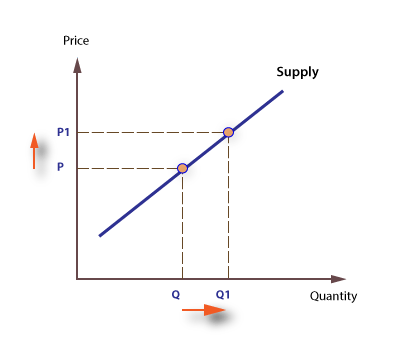Supply is the willingness and ability of producers to create goods and services to take them to market. Supply is positively related to price given that at higher prices there is an incentive to supply more as higher prices may generate increased revenue and profits. It is an economic term that refers to the amount of a given product or service that suppliers are willing to offer to consumers at a given price level at a given period.
Suppliers must anticipate price changes and quickly react to changes in demand or price. However, some market factors are hard to predict. For instance, the yield of commodities cannot be accurately estimated, yet their yields strongly affect prices.

When the price of a product is low, the supply is low. When the price of a product is high, the supply is high. This makes sense because companies are seeking profits in the market place. They are more likely to produce products with a higher price and likelihood of producing profits than not.
Factors of Supply
The factors of supply for a given product or service is related to:
- The price of the product or service
- The price of related goods or services
- The prices of production factors
- The price of inputs
- The number of production units
- Production technology
- Expectations of producers
- Government policies
- Random, natural or other factors
In the goods market, supply is the amount of a product per unit of time that producers are willing to sell at various given prices when all other factors are held constant. In the labor market, the supply of labor is the amount of time per week, month, or year that individuals are willing to spend working, as a function of the wage rate.
In financial markets, the money supply is the amount of highly liquid assets available in the money market, which is either determined or influenced by a country’s monetary authority. This can vary based on which type of money supply one is discussing.
Factors affecting supply
Innumerable factors and circumstances could affect a seller’s willingness or ability to produce and sell a good. Some of the more common factors are:
- Good’s own price: The basic supply relationship is between the price of a good and the quantity supplied. Although there is no “Law of Supply”, generally, the relationship is positive, meaning that an increase in price will induce an increase in the quantity supplied.
- Prices of related goods: For purposes of supply analysis related goods refer to goods from which inputs are derived to be used in the production of the primary good. For example, Spam is made from pork shoulders and ham. Both are derived from pigs. Therefore, pigs would be considered a related good to Spam. In this case the relationship would be negative or inverse. If the price of pigs goes up the supply of Spam would decrease (supply curve shifts left) because the cost of production would have increased. A related good may also be a good that can be produced with the firm’s existing factors of production. For example, suppose that a firm produces leather belts, and that the firm’s managers learn that leather pouches for smartphones are more profitable than belts. The firm might reduce its production of belts and begin production of cell phone pouches based on this information. Finally, a change in the price of a joint product will affect supply. For example, beef products and leather are joint products. If a company runs both a beef processing operation and a tannery an increase in the price of steaks would mean that more cattle are processed which would increase the supply of leather.
- Conditions of production: The most significant factor here is the state of technology. If there is a technological advancement in one good’s production, the supply increases. Other variables may also affect production conditions. For instance, for agricultural goods, weather is crucial for it may affect the production outputs. Economies of scale can also affect conditions of production.
- Expectations: Sellers’ concern for future market conditions can directly affect supply. If the seller believes that the demand for his product will sharply increase in the foreseeable future the firm owner may immediately increase production in anticipation of future price increases. The supply curve would shift out.
- Price of inputs: Inputs include land, labor, energy and raw materials. If the price of inputs increases the supply curve will shift left as sellers are less willing or able to sell goods at any given price. For example, if the price of electricity increased a seller may reduce his supply of his product because of the increased costs of production. Fixed inputs can affect the price of inputs, and the scale of production can affect how much the fixed costs translate into the end price of the good.
- Number of suppliers: The market supply curve is the horizontal summation of the individual supply curves. As more firms enter the industry, the market supply curve will shift out, driving down prices.
- Government policies and regulations: Government intervention can have a significant effect on supply. Government intervention can take many forms including environmental and health regulations, hour and wage laws, taxes, electrical and natural gas rates and zoning and land use regulations.
Supply function assumptions
1) Constant returns to scale could be permitted, in which case, if profit maximization at a nonzero output is possible at all, then it necessarily occurs at all levels of output.
2) Shifting from the short-run to the long-run context imposes a second form of assumption modification. This requires the elimination of all fixed inputs so that each b il = 0, and the inclusion of the long-run equilibrium condition π il = 0 for every firm.
3) A third possibility for assumption modification is the introduction of imperfectly competitive elements that give firms some influence over the prices they charge for their outputs.